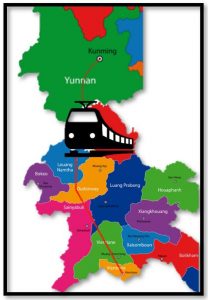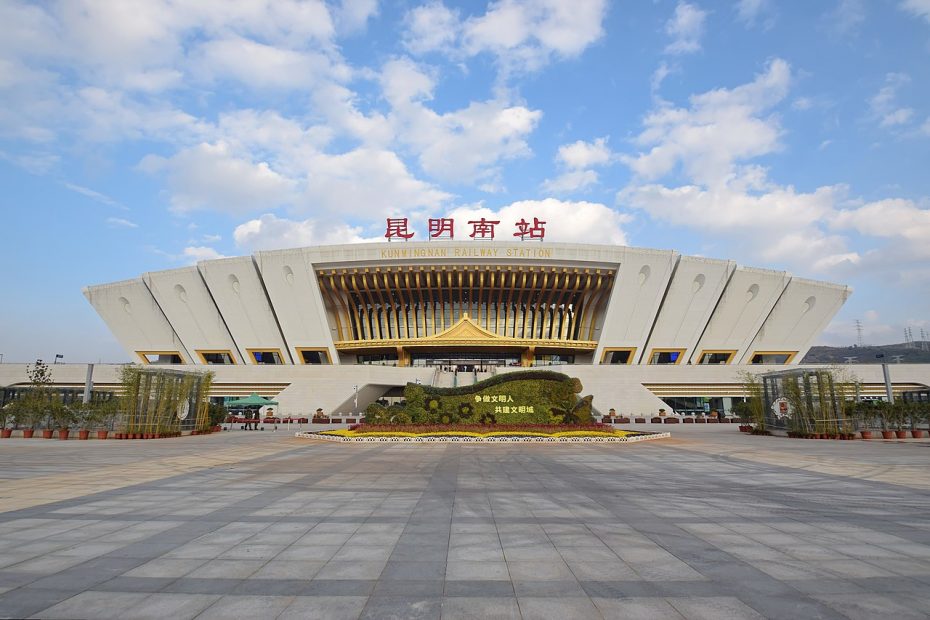Transportation has a very important role in supporting economic growth and is quite crucial in economic development. The success of development in the economic sector must be supported by developing a good transportation system according to the needs. Laos is one of the southeast Asian countries where the mainland controls the area. Laos is also a small and developing country where there are still many areas that have not yet been fulfilled by physical infrastructure. Therefore, China involved Laos in the Belt and Road Initiative (BRI) project to build a silk route that was once built during the Han dynasty. The China-Laos railway is the No. 1 project in Laos’ 8th Five-Year Plan, and it will bring considerable benefits to Laos. The railway, which is more than 400 kilometres, connects the Mohan – Boten border gate in northern Laos and the capital Vientiane. More than 60 per cent of the railway consists of bridges and tunnels. The designed speed of the rail line is 160 km per hour. The railway will promote Laos’ economic development and increase the income of the Lao people. By adding that, the rail line will help attract foreign investment and create more job opportunities for Laos. Construction on the railway started in 2016 and is expected to finish within five years, with a total investment of about 40 billion yuan (US$5.9 billion).
Many consider that this project is nothing but wasteful and unnecessary. The debt burden of Laos from this project worries several entities, such as the World Bank and the Asian Development Bank. For this project, Laos must make an enormous contribution, for US $ 720 million. The project is also 70% funded by the Chinese government, while Laos receives the highest income from its agricultural products, paying the remaining 30% by borrowing from Chinese funding agencies. Laos’s debt on this project has a term of 30 years without interest with a return of 2% per year. However, infrastructure investment in Laos is one of China’s efforts to create a Belt and Road Initiative, especially in the local area. China dominates investments that enter Laos, and the inflow of capital from China influences the development and progress of the Sustainable Development Goals (SDG) in Laos itself.
Economic growth is closely related to sustainable development in the transportation sector. This relationship between economics and transportation is emphasized on the role of the transportation sector in opening up the isolation of an area, which will have a significant economic impact on the welfare of the people in the region. In 2021 Laos has the vision to become the Land-link country. This vision is the expression of Laos to have a fresh start for the new economic cycle in the local area, especially in the capital city of Vientiane. Laos wants to change the perception of being a Landlocked country to become a land-linked country. So then Laos can be the bridge to provide land transportation routes to other countries. Therefore this fast train project can play a role in sustainable development to build a robust infrastructure, encourage inclusive and sustainable industrialization, and encourage innovation.
 The line will run through 25 stations from Kunming, Yuxi, Pu’er, Xishuangbanna, Mohan China, Thru Laos from Boten, Nateuy, Na Mor, Muong Xai, Ban NakhokTay, Huoi Phoulai, Luang Prabang, XiengNgeun, Ban Sen, Kasi, Ban Bua Pheouk, Pha Tang, Vang Vieng, Ban Vang Mon, Vang Khi, Hin Hoeup, Phonhong, Ban Sakha, Ban Phonh Sung, Vientiane Neua (Vientiane North) and Vientiane Tay (Vientiane Main Station). A further 12 stations are being planned for future development.
The line will run through 25 stations from Kunming, Yuxi, Pu’er, Xishuangbanna, Mohan China, Thru Laos from Boten, Nateuy, Na Mor, Muong Xai, Ban NakhokTay, Huoi Phoulai, Luang Prabang, XiengNgeun, Ban Sen, Kasi, Ban Bua Pheouk, Pha Tang, Vang Vieng, Ban Vang Mon, Vang Khi, Hin Hoeup, Phonhong, Ban Sakha, Ban Phonh Sung, Vientiane Neua (Vientiane North) and Vientiane Tay (Vientiane Main Station). A further 12 stations are being planned for future development.
This could be a major impact on every sector of the economy in each area of the city, such as opening a mini-market, restaurant, even a gift shop at the station, or any location near the station which will open up jobs opportunities for the local population like one of the sustainable development goals that can promote sustainable, inclusive and sustainable economic growth, full and productive employment, and decent work for all.
Laos is directly adjacent to China, Vietnam, Cambodia, Thailand, and Myanmar. The railways can start turning it into profit by making Laos a useful intermediary for neighbours who wish to trade with one another. Laos exports agricultural products, mining products (including copper), gold, apparel, electricity, and wood and wood products. The main importers for Laos’s export commodities are Thailand, China, and Vietnam. Laos import commodities such as construction materials, machinery, fuel, foodstuffs, vehicles and spare parts, production equipment, and consumer goods. The main exporters of imported Laos commodities are Thailand, China, Vietnam, and Japan. It could be one of the innovations to introduce a new rail network based on travel between cities and countries.
Along with introducing a new rail network based on inter-city and state travel, there will be a population movement between Kunming and Vientiane, as there will be immigration, which will affect economic growth. By also introducing Transit-Oriented Development (TOD), a population movement that will affect economic growth, which Laos’s economic growth is hampered by the lack of human resources in a country of around 7 million people. Many educated circles choose to move abroad to find work with a high standard of pay. It causes many Laotian to prefer to study outside the country. But with this BRI project can also develop the quality of education in Vientiane; the particular reason for this circumstance is there will be many Chinese arrivals where Mandarin can become the second language in Vientiane City or the Laos country itself. There will be a lot of educational cooperation between Vientiane and Kunming, considering the education system in China is much better than in Laos; hence it will be very beneficial for both countries in terms of education exchange.
The railway is expected to increase agricultural production, manufacturing, logistics services, and tourism. It will be better if Laos creates the necessary supporting infrastructure. Roads and other infrastructure are needed to support and facilitate access to and from the railway. For example, railway stations need to serve both freight and passengers, so accessibility between the railway and farms, factories, and other industrial assets is required. The trucking and logistics sectors will also be needed to improve competition in the transport sector, increasing the possibility that the railway will be supported and utilized. Local connectivity is the key to leverage opportunities posed by the railway. Based on the fact as mentioned earlier, this railway project can also be used as The Transit Oriented Development (TOD), which can increase the productivity of railway services between the provinces with the presence of Laos – China high-Speed Railway stations. The gain in Laos increases significantly with Transit-Oriented Development (TOD). Implementing new transportation infrastructure Transit-Oriented Development (TOD) will improve the efficiency of the existing transportation system in Laos. It shows that the gains from Transit Oriented Development (TOD) can be from various facilities that are available in the train station area such as mini markets, restaurants, malls, and even from residential areas can be an opportunity to improve the economy in the region, but the disadvantage of TOD is that increase the regional disparity. For instance, if the provinces along the railway lose, then the whole country will experience less growth.
About the writer:
Nikita Elizabeth Cristine, Bachelor student on Urban and regional planning, Esa Unggul University and research Intern at the UCLG ASPAC Secretariat.
REFERENCES
Gretchen A. Kunze, V. Bruce J. Tolentino ‘In Laos: Land-linked, not Land-locked’ The Asia Foundation- August 27, 2008 (https://asiafoundation.org/2008/08/27/in-laos-land-linked-not-land-locked/ ) (Accessed April 20,2021)
Ant, Jurnalis ‘China-Laos Akan TerhubungKeretaApi di 2021’ Oke Finance– Nov 22, 2017 [https://economy.okezone.com/read/2017/11/22/320/1818341/china-laos-akan-terhubung-kereta-api-di-2021 ] (Accessed April 20,2021)
Kunze, Gretchen, danTolentino, Bruce J, 2008. In Laos:Land-linked, not Land-locked. The Asia Foundation.Dalam https://asiafoundation.org/2008/08/27/in-laos-land-linked-not-land-locked/ [(Accessed April 23 ,2021)
Don Ross ‘Rail line through Laos ready in 2021’ TTRW -September 21, 2018 [https://www.ttrweekly.com/site/2018/09/rail-line-through-laos-ready-in-2021/ ] (Accessed April 23 ,2021)
RFA’s Laos Service. Translated by Ounkeo Souksavanh. Written in English by Roseanne Gerin. ‘ Laos And China Come to Terms on Loan Interest Rate For Railway Project’ Radio Free Asia– 2016-01-04 [https://www.rfa.org/english/news/laos/laos-china-come-to-terms-on-loan-interest-rate-for-railway-project-01042016163552.html ] (Accessed April 26 ,2021)
Zsombor Peter ‘Laos Braces for Promise, Peril of China’s High-Speed Railway’ VOA News – March 04, 2021) [www.voanews.com] (Accessed April 29 ,2021)
Business Reporting Desk ‘China-Laos Railway keeps Extending North’ Belt and Road News – May 11, 2020) [https://www.beltandroad.news/china-laos-railway-keeps-extending-north/] (Accessed May 1 ,2021)
Encyclopaedia Britannica ‘Vientianenational capital, Britannica Jul 14, 2016 ](https://www.britannica.com/place/Vientiane ) (Accessed May 4 ,2021)
Feature Image retrieve from https://en.wikipedia.org/wiki/Kunming_South_railway_station
